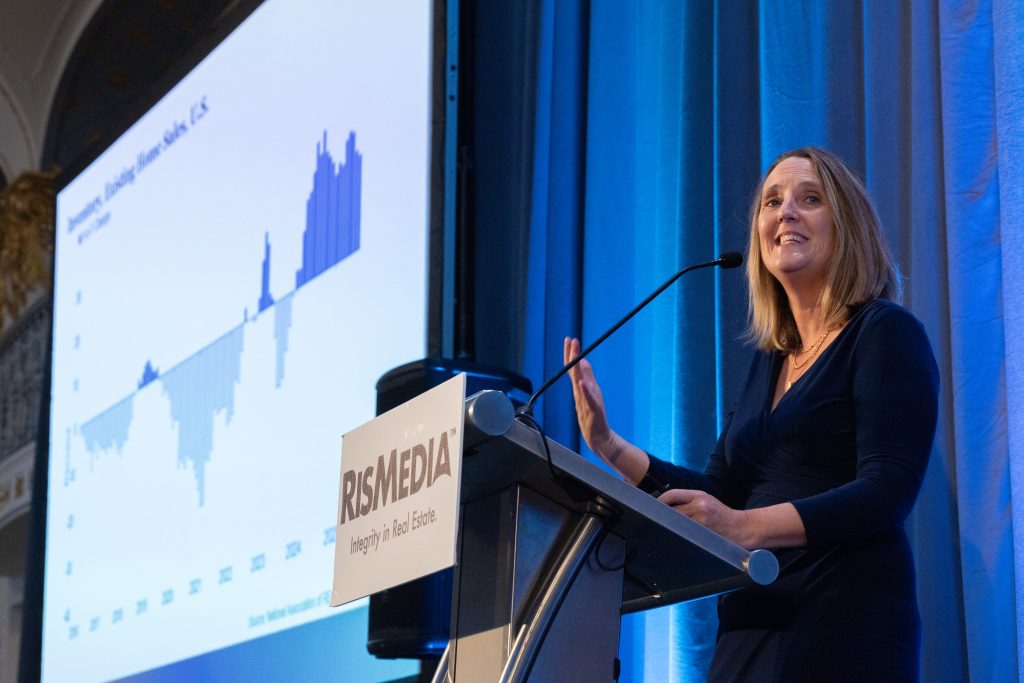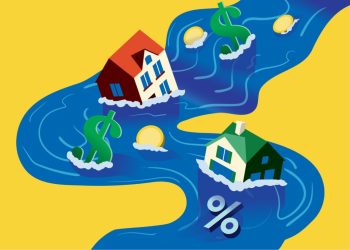Above: Bright MLS Chief Economist Lisa Sturtevant. Photo by AJ Canaria.
While all eyes might be on America’s favorite celebrity couple—Travis and Taylor—there’s another high-stakes relationship unfolding behind the scenes with far greater implications for the housing market.
That’s the relationship between Federal Reserve Chair Jerome Powell and President Donald Trump, arguably the most influential duo in U.S. economic policy today.
And, according to Bright MLS Chief Economist Lisa Sturtevant—who shared her perspective on real estate trends in the D.C. area and beyond at RISMedia’s 37th Annual CEO & Leadership Exchange earlier this month—this relationship, more than any other, is critical when it comes to understanding what to expect in the housing market.
“This isn’t a political statement, but I’m just saying that there are a lot of ramifications for how the relationship between the executive branch and the central bank proceeds, and it’s something we’re watching very carefully,” said Sturtevant, who argued that there’s something really unique about where we are right now, underscoring the importance of understanding where we are at this point in time and how it might affect the housing market for the rest of the year and into 2026.
Diving right in, Sturtevant noted that the federal government has had an impact on the housing market in the United States for over a century now, so it’s important to keep in mind that this is nothing new.
In fact, according to Sturtevant, there have been many periods throughout history where the federal government has played a role—and more recently since the 2000s—pointing to federal legislation that has shaped the housing market through the creation of the FHA through the GI bills, through other ways in which demand has been impacted.

Photo by AJ Canaria.
“We know there has been the impact of regulation, or maybe the lack of regulation on the mortgage market. We know there were fiscal and monetary policy responses to the mortgage crisis of the great financial crisis during the pandemic,” explained Sturtevant. “The pandemic hit, and we know that there were fiscal interventions, there were monetary policy interventions—and we’re still dealing with those interventions from the federal government and their effects on the housing market over the last presidential cycle.”
Heading into the midterms, Sturtevant noted that there’s a lot of conversation about housing affordability as a federal issue—with the president and Treasury Secretary Scott Bessent perhaps declaring a national housing emergency due to there being so much interest in housing affordability being an issue for all of us.
“I think part of the reason is the affordability challenge has moved up the income ladder. It used to be when we think about the difficulty of buying a home or renting a place, that was maybe for other people, but now it’s for our adult children. It’s for the folks that work in our office. Heck, it’s for us,” explained Sturtevant.
But what does this mean for where we are now post-COVID?
“We’re still in that one- to three-year cycle. And a large part of this cycle is due to the fact that the federal government did a lot of things that affected the housing market—limited inventory, affordability challenges, declining mobility. I don’t know if we often think about that, but the fact that the housing market is locked down is affecting people’s ability to move,” said Sturtevant.
“And when people move, they often move for economic opportunity, and if you don’t have that chance to move for economic opportunity, it will have a negative impact on the economy,” she added.
“So when people ask whether it’s a buyer’s market or a seller’s market, it’s really neither. Buyers are blocked out, and sellers are locked in—and it’s really this market that’s feeling very stuck. A lot of it has to do with where we were at during COVID, and this market is transitioning in very different ways depending on where you’re going.”
Market conditions on a national scale
Next, Sturtevant drilled down into some key data points related to where the housing market stands on a national scale—beginning with home sales activity, a metric that has been very, very low.
While the total number of home sales in the United States numbered 6 million in 2021, Sturtevant noted that they dropped to about 5 million in both 2022 and 2023, before dropping to 4 million in 2024—which she predicts is about where we’ll be as we finish off the year.
“Part of that is cyclical, and part of it is those factors that are keeping people stuck and keeping people locked out of the market,” explained Sturtevant. “But if we’re thinking about how the pendulum is going to swing, and where we might head, you can see where we have to go. We’re very much at the bottom of this 10-year trend.”
From there, Sturtevant turned to the big jump in home prices between 2020 and 2021, pointing to the stimulus checks that got put in mailboxes and mortgage rates falling to record lows as two pieces of federal intervention that drove housing market activity and helped to shape where we are now.
“If you’re a homebuyer in the market now, and you’re seeing high home prices, it’s not because of what happened last year. It’s because of where we’ve been over the last five years,” she noted. “But look what’s happened now. You can see the median sold price here in the U.S. has started to fall a little bit more steeply than it would in a normal market, so we’re seeing this shift. We’re seeing this change. And one of the reasons why home prices do continue to rise is because we’ve seen inventory really low.”
Sturtevant went on to note that while inventory has been rising for the past year and a half due to more new homes being on the market, and also because buyers have been holding back, it has created a narrative with headlines claiming inventory is back to pre-pandemic levels—or those seen in 2019.
“Part of that is because we’re seeing more listings coming onto the market, and part of that is because we’re seeing less demand,” said Sturtevant, who further explained that this isn’t true everywhere.
In fact, in the D.C. area, inventory is still about 85% of where it was prior to the pandemic, while it stands at just 65% of 2019 levels in Central Pennsylvania.
“One of the things we have to think about is that as the federal government has intervened on the policy side—fiscal policy, monetary policy—there are still very local market conditions that are going to drive the housing market here at the end of the year,” added Sturtevant.
“We can watch the Fed, and we can talk about rate cuts, but we need to watch what else is going on here in the federal government and think about what the potential unintended consequences might be that might cause us to expect a continuation of this relatively slow, relatively stuck housing market as we head into 2026.”
Sturtevant ended on a positive note, pointing to the opportunity present in today’s market.
“I feel like we’ve spent a lot of time over the last year talking about how brokers and agents demonstrate value to their clients during the transaction—and your value is never more important than it is during a period of transition,” said Sturtevant.
“At the end of the day though, the value that you bring is all about providing education, providing intelligence, providing knowledge and expertise on what’s going on in your local market so that you can be that resource in this environment, which is very uncertain and very unusual.”












